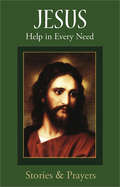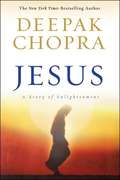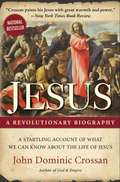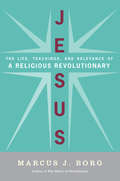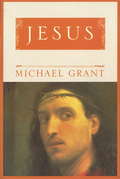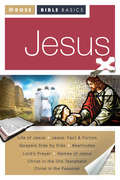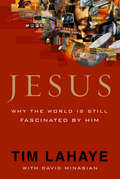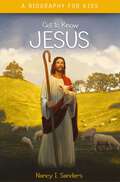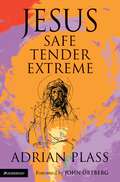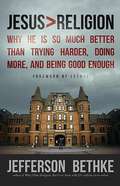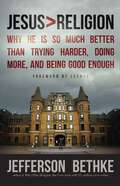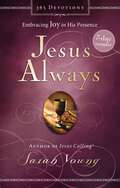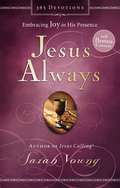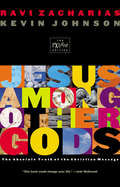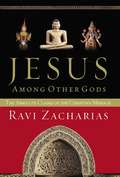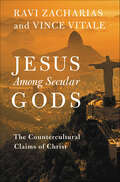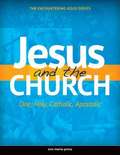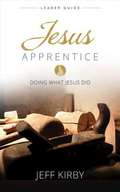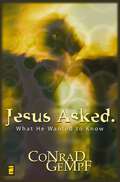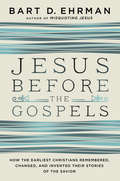- Table View
- List View
Jesus
by Christina Setticase Kathryn J. HermesStories from Scripture, true life experiences and prayers from the Christian tradition draw the reader to look at life from a renewed perspective. In these pages you will be challenged to make changes in your life, your way of thinking and your choices. Allow the Lord's unconditional love and limitless mercy to transform your life.
Jesus
by Deepak ChopraThe New York Times bestselling author of Buddha captures the extraordinary life of Jesus in this surprising, soul-stirring, and page-turning novel. Uncovering the transformational "lost years" that are not recounted in the New Testament, Deepak Chopra has imagined Jesus's path to enlightenment moving from obscurity to revolutionary, from doubt to miracles, and then beyond as the role of the long-awaited Messiah. As a teenager, Jesus has premonitions of his destiny, and by the end, as he arrives to be baptized in the River Jordan, he has accepted his fate, which combines extremes of light and darkness. With his characteristic ability for imparting profound spiritual insights through the power of storytelling, Deepak Chopra's Jesus portrays the life of Christ as never before, ultimately leading us closer to understanding the nature of God and the soul. As the author shares, "I don't want the Jesus in this book to be worshiped, much less to push him forward as definitive. The events of the tale are pure fiction. But at a deeper level, the Jesus in this book feels real because we've gotten a glimpse into his mind. One flash of insight answers many prayers."
Jesus
by John Dominic CrossanThe Controversial, Bestselling Account of What We Can Know About the Life of Jesus
Jesus
by Marcus J. BorgFrom top Jesus expert Marcus Borg, a completely updated and revised version of his vision of Jesus--as charismatic healer, sage, and prophet, a man living in the power of the spirit and dedicated to radical social change. Fully revised and updated, this is Borg's major book on the historial Jesus. He shows how the Gospel portraits of Jesus, historically seen, make sense. Borg takes into account all the recent developments in historical Jesus scholarship, as well as new theories on who Jesus was and how the Gospels reflect that. The original version of this book was published well before popular fascination with the historical Jesus. Now this new version takes advantage of all the research that has gone on since the 80s. The revisions establish it as Borg's big but popular book on Jesus.
Jesus
by Michael GrantA study of the life of Jesus by one of the great scholars of the ancient world.Examining the Gospels as he would any other historical document, Grant presents a picture of Jesus that is, in some respects, an unfamiliar one. He argues that Jesus was neither meek and mild, nor a political revolutionary, but rather consumed with the goal of the realisation of the Kingdom of God.
Jesus
by Paul MobleyThis book takes a look at the life of Jesus through His teachings and actions while on earth. Much more can be learned by reading the four gospels, yet this book should give a good idea of Jesus.
Jesus
by Rose PublishingRose Bible Basics: Jesus - Who is Jesus?How is Jesus different from all other religious leaders in the world? The full-color Rose Bible Basics: Jesus book provides you with a solid introduction to the life of Jesus, his teachings, and the significance of his death and resurrection. Each chapter of this book will help you discover the life-changing impact of Jesus of Nazareth. Chapters in Rose Bible Basics: Jesus include: *Who is Jesus?This chapter helps to explain why Jesus came, what He taught and did, and why He had to die. It includes the "life of Jesus" in chart form, the "beliefs about Jesus" chart, and a "Christ's deity" chart. *Jesus: Fact or Fiction? Topics in this section include: *Was Jesus of Nazareth a mythical figure? *Where was Jesus during the "Lost Years"? *Have archaeologists really found Jesus' bones? *The Gospels Side by SideThis section includes a chart exploring the harmony of the gospels regarding the life of Jesus. It also covers such topics as *Why are there four gospels? *The gospels as biographyThis section helps explain Jesus' Passover meals, His miracles, parables, where He walked, and even includes a map of how Israel probably looked during the time of Jesus. *The BeatitudesThis section reveals why the much beloved Beatitudes of Jesus' sermon on the mount are still relevant wherever there is suffering, injustice, and a need for God today. They bring comfort to a weary heart, and joy in times of trial. This chapter will explain what the beatitudes are and how they relate to believers today. *The Lord's PrayerKnow God's Power and Forgiveness through 7 Petitions: *God's Fatherly Love *God's Holiness *God's Sovereignty *Authority *Providence *Mercy and Protection *Names of JesusThis section gives 50 names of Jesus and the meaning of each name with its Bible reference. This section also compares Jesus to: Adam, Noah, Abraham, Melchizedek, Joseph, Moses, Joshua, Samuel, David, Elijah and Elisha, and Zerubbabel, as many of these men foreshadowed the coming of the true messiah. *Christ in the Old TestamentThis popular section includes a chart that selects 13 people in the Old Testament who foreshadowed Jesus Christ. The Christ in the Old Testament section also provides 20 Biblical prophecies fulfilled by Jesus in His first coming.
Jesus
by Thomas NelsonCoinciding with the "It's All About Jesus" campaign, this major release explores, in depth, the eight major character traits of Jesus, leading readers to a fuller understanding of the depth and breadth of Jesus' personality. Today's top Christian authors--Max Lucado, John Eldredge, Anne Graham Lotz, John MacArthur, Stormy Omartian, and others--will teach readers that Christ is so much more than just an important figure who lived two thousand years ago. He's our: Lord Mighty Warrior Friend Teacher Healer Prince of Peace Lover of Our Souls Savior The best teachers of today make use of scripture exploration, personal application, discussion questions, even poems and hymns, to bring the multifaceted personality of Jesus into focus in a way never before accomplished. If you're only going to read one book to better get to know the full person of Jesus this year, let this be the book.
Jesus
by Tim LahayeJesus. Love Him or hate Him, He's everywhere. On our t-shirts, bumper stickers, and even on the covers of leading news magazines, year after year. We see Him on the silver screen, in the headline crawl on the TV news, and on the homemade signs held up at ball games. Hotly debated, He remains the most conspicuous figure of all time, even twenty decades after His inglorious death.Best-selling author Tim LaHaye, together with coauthor David Minasian, looks back through history and peers into the prophetic future to show us why the world's "Jesus Fascination" should come as no surprise. After reading about Jesus' life, legacy, and pervasive influence, you may find yourself connecting the dots of your own spiritual journey and answering the timeless question that came from the lips of Jesus Himself: Who do you say that I am?
Jesus (Get to Know)
by ZondervanJesus—part of the Get to Know series—is a unique biography about Jesus, the son of God. Focusing on the life and character of this Biblical hero, using color photographs, maps, and other visual resources to tell the whole story, young biography fans will come to learn more about this man of the God and the role he plays in history.Featuring a bibliography and scriptural references throughout, this is sure to become a favorite for young readers and for first book reports.
Jesus (Phoenix Giants Ser.)
by Michael GrantA study of the life of Jesus by one of the great scholars of the ancient world. Examining the Gospels as he would any other historical document, Grant presents a picture of Jesus that is, in some respects, an unfamiliar one. He argues that Jesus was neither meek and mild, nor a political revolutionary, but rather consumed with the goal of the realisation of the Kingdom of God.
Jesus - Safe, Tender, Extreme
by Adrian PlassEvocative reflections on three facets in our relationship with Jesus. People long for reality in their walk with Christ. To know him better, we must understand the different sides of his complex nature. Popular British author Adrian Plass draws on biblical stories and personal experience—as well as his keen understanding of people’s needs—as he explores the Safe Jesus, the Tender Jesus, and the Extreme Jesus. God has told us that he holds us in the palm of his hands, where no one and nothing can harm the most important part of us. But from biblical times to the present day, Christians encounter accidents and disasters. What does it really mean to experience the Safe Jesus? Jesus tells his disciples that they must love one another. Yet time and again we try to find achievement and success through our own efforts and individual gifts, only to end in failure. Instead, we need to know the Tender Jesus who becomes visible when we join with each other in the body of Christ. Jesus only did what he saw his father doing. Each of his actions and encounters were fueled, informed, and instructed by the dynamic, creative, unpredictable Spirit of God. Failing to be obedient in this way is what truly constitutes sin. When we are open to the genuine leading of the Spirit, we will experience the Extreme Jesus. In Jesus – Safe, Tender, Extreme, Adrian Plass is “simply a man with a broom, sweeping away the rubbish that prevents others from passing further in and further up, by talking about what Jesus does and doesn’t do in my life.”
Jesus > Religion: Why He Is So Much Better Than Trying Harder, Doing More, and Being Good Enough
by Jefferson BethkeAbandon dead, dry, rule-keeping and embrace the promise of being truly known and deeply loved. Jefferson Bethke burst into the cultural conversation in 2012 with a passionate, provocative poem titled “Why I Hate Religion, But Love Jesus.” The 4-minute video literally became an overnight sensation, with 7 million YouTube views in its first 48 hours (and 23+ million in a year). The message blew up on social-media, triggering an avalanche of responses running the gamut from encouraged to enraged. In Jesus > Religion, Bethke unpacks similar contrasts that he drew in the poem—highlighting the difference between teeth gritting and grace, law and love, performance and peace, despair and hope. With refreshing candor he delves into the motivation behind his message, beginning with the unvarnished tale of his own plunge from the pinnacle of a works-based, fake-smile existence that sapped his strength and led him down a path of destructive behavior. Bethke is quick to acknowledge that he’s not a pastor or theologian, but simply a regular, twenty-something who cried out for a life greater than the one for which he had settled. Along his journey, Bethke discovered the real Jesus, who beckoned him beyond the props of false religion.
Jesus > Religion: Why He Is So Much Better Than Trying Harder, Doing More, and Being Good Enough
by Jefferson BethkeAbandon dead, dry, religious rule-keeping and embrace the promise of being truly known and deeply loved.Jefferson Bethke burst into the cultural conversation with a passionate, provocative poem titled "Why I Hate Religion, But Love Jesus." The 4-minute video became an overnight sensation, with 7 million YouTube views in its first 48 hours (and 23+ million in a year).Bethke's message clearly struck a chord with believers and nonbelievers alike, triggering an avalanche of responses running the gamut from encouraged to enraged.In his New York Times bestseller Jesus > Religion, Bethke unpacks similar contrasts that he drew in the poem--highlighting the difference between teeth gritting and grace, law and love, performance and peace, despair, and hope.With refreshing candor, he delves into the motivation behind his message, beginning with the unvarnished tale of his own plunge from the pinnacle of a works-based, fake-smile existence that sapped his strength and led him down a path of destructive behavior. Along the way, Bethke gives you the tools you need to:Humbly and prayerfully open your mindUnderstand Jesus for all that he isView the church from a brand-new perspectiveBethke is quick to acknowledge that he's not a pastor or theologian, but simply an ordinary, twenty-something who cried out for a life greater than the one for which he had settled. On this journey, Bethke discovered the real Jesus, who beckoned him with love beyond the props of false religion.Praise for Jesus > Religion:"Jeff's book will make you stop and listen to a voice in your heart that may have been drowned out by the noise of religion. Listen to that voice, then follow it--right to the feet of Jesus." --Bob Goff, author of New York Times bestsellers Love Does and Everybody, Always"The book you hold in your hands is Donald Miller's Blue Like Jazz meets C. S. Lewis's Mere Christianity meets Augustine's Confessions. This book is going to awaken an entire generation to Jesus and His grace." --Derwin L. Gray, lead pastor of Transformation Church, author of Limitless Life: Breaking Free from the Labels That Hold You Back
Jesus Always 7-Day Sampler (Jesus Always)
by Sarah YoungThis eBook is a free 7-day devotional sampler from Sarah Young&’s new book, Jesus Always—her first 365-day devotional since Jesus Calling®. Millions of people have been inspired by the writings of Sarah Young. With scripture and new personal reflections, these devotions will gently connect you with Jesus—the One who meets you where you are and loves you always. The full book is available at eBook retailers everywhere.www.jesuscalling.comFacebook /JesusCallingTwitter @Jesus_Calling
Jesus Always, with Scripture References, with Bonus Content: Embracing Joy in His Presence (a 365-Day Devotional) (Jesus Always)
by Sarah YoungThis ebook includes the full text of the book plus three exclusive 14-day topical readings from Sarah Young not found in the hardcover!Life today is full of difficulties—loss, sadness, anxiety, fear, and uncertainty. In the midst of these challenges, joy and contentment often feels impossible or out of reach.Experience Jesus' message of joy today and every day with this 365-day devotional from New York Times bestselling author Sarah Young.Jesus has more in store for you than a life of striving, pain, and discontent. Take the time to draw near to Him with Jesus Always, and you will discover how to:Intimately and gently connect with Jesus—the One who meets you where you areIdentify joy-filled reminders from the BibleProcess challenging situations, anxiety, and grief with a hopeful perspectiveStrengthen your faith and your relationship with JesusJesus Always includes:365 days of Bible-based devotionsScripture references for each devotionpersonal reflections from Saraha ribbon markerWritten as if Jesus Himself is speaking directly to you, Jesus Always invites you into a new way of living—a life of joy.Look for additional life-changing, life-giving books from Sarah Young including:Jesus CallingJesus ListensJesus TodayJesus Calling for MomsJesus Calling for Christmas
Jesus Always: 365 Devotions for Kids (Jesus Always)
by Sarah YoungEmbrace the true meaning of Joy with the young believers in your life with Sarah Young's 365-day devotional, Jesus Always: 365 Devotions for Kids. Encourage them to sit with God's word and find an abundance of joy during good times and hard in these short, simple devotions for children.In Sarah Young's 365-day devotional for kids, Jesus Always: 365 Devotions for Kids, she focuses on the biblical teaching of the joy we can experience at any time and in all circumstances. With Scripture and new personal reflections, she brings Jesus' message of joy--for today and every day--to children.Adapted from the bestselling Jesus Always, each day's devotion has the same theme as the adult version, as well as written-out Scriptures, making it a great choice for families to read and discuss during devotional time together. Jesus Always: 365 Devotions for Kids will engage your children and help them find lifelong true contentment and joy.In Jesus Always: 365 Devotions for Kids, your 6- to 12-year-old child willFeel comforted by words of joy and hopeBe reassured of Jesus' unending love for themReceive gentle guidance based on ScriptureRead scripture verses that strengthen their faithConnect with Jesus further as they reflect and meditate on God's WordSarah Young's children titles:Make a great Christmas, holiday, or baptism giftSupport kids and tweens as they grow into their faithAre a wonderful bible study, small group, or youth ministry resourceReaching out with joy-filled reminders from the Word of God, these devotions will intimately and gently connect your children with Jesus--the One who meets you where you are.
Jesus Among Other Gods
by Ravi ZachariasIn a world with so many religions, why Jesus?We are living in a time when you can believe anything, as long as you do not claim it to be true. In the name of "tolerance," our postmodern culture embraces everything from Eastern mysticism to New Age spirituality. But as Ravi Zacharias points out, such unquestioning acceptance of all things spiritual is absurd. All religions, plainly and simply, cannot be true.Jesus Among Other Gods provides the answers to the most fundamental claims about Christianity, such as:Aren't all religions fundamentally the same?Was Jesus who He claimed to be?Can one study the life of Christ and demonstrate conclusively that He was and is the way, the truth, and the life?In each chapter, Zacharias considers a unique claim that Jesus made and then contrasts the truth of Jesus with the founders of Islam, Hinduism, and Buddhism with compelling insight and passionate conviction. In addition to an impressive breadth of reading and study, he shares his personal journey from despair and meaninglessness to his discovery that Jesus is who He said He is."In Jesus Among Other Gods, Ravi Zacharias demonstrates that he is one of the most intellectually gifted as well as spiritually sensitive writers of today's leading apologists for the Christian faith. Zacharias brings alive the unique power of the claims of Jesus about himself and the utter relevance of his message today for the human condition." -- David Aikman, author of Great Souls
Jesus Among Other Gods: The Absolute Claims of the Christian Message
by Ravi ZachariasIn a world with so many religions, why Jesus?We are living in a time when you can believe anything, as long as you do not claim it to be true. In the name of “tolerance,” our postmodern culture embraces everything from Eastern mysticism to New Age spirituality. But as Ravi Zacharias points out, such unquestioning acceptance of all things spiritual is absurd. All religions, plainly and simply, cannot be true.Jesus Among Other Gods provides the answers to the most fundamental claims about Christianity, such as:Aren’t all religions fundamentally the same?Was Jesus who He claimed to be?Can one study the life of Christ and demonstrate conclusively that He was and is the way, the truth, and the life?In each chapter, Zacharias considers a unique claim that Jesus made and then contrasts the truth of Jesus with the founders of Islam, Hinduism, and Buddhism with compelling insight and passionate conviction. In addition to an impressive breadth of reading and study, he shares his personal journey from despair and meaninglessness to his discovery that Jesus is who He said He is.“In Jesus Among Other Gods, Ravi Zacharias demonstrates that he is one of the most intellectually gifted as well as spiritually sensitive writers of today’s leading apologists for the Christian faith. Zacharias brings alive the unique power of the claims of Jesus about himself and the utter relevance of his message today for the human condition.” — David Aikman, author of Great Souls
Jesus Among Secular Gods: The Countercultural Claims of Christ
by Ravi Zacharias Vince VitaleRavi Zacharias and Vince Vitale defend the absolute claims of Christ against modern belief in the "secular gods" of atheism, scientism, relativism, and more.The rise of these secular gods presents the most serious challenge to the absolute claims of Christ since the founding of Christianity itself. The Christian worldview has not only been devalued and dismissed by modern culture, but its believers are openly ridiculed as irrelevant. In Jesus Among Secular Gods, Ravi Zacharias and Vince Vitale challenge the popular "isms" of the day, skillfully pointing out the fallacies in their claims and presenting compelling evidence for revealed absolute truth as found in Jesus. This book is fresh, insightful, and important, and faces head on today's most urgent challenges to Christian faith. It will help seekers to explore the claims of Christ and will provide Christians with the knowledge to articulate why they believe that Jesus stands tall above all other gods.
Jesus And The Church: One, Holy, Catholic, Apostolic
by Ave Maria Press Inc.Students deepen their understanding of Jesus Christ, the fullness of God's Revelation, as they encounter him in the living Body of Christ, the Catholic Church. Jesus and the Church: One, Holy, Catholic, Apostolic supports Course IV of the USCCB curriculum and is the first high school textbook released by Ave Maria Press in its new Encountering Jesus series. As they engage with the content of this text, students will recognize Christ present and active in their lives through the visible and vibrant mission of Church, defined by her four characteristics--one, holy, catholic, and apostolic. While Jesus and the Church places the foundations of the Church in their historical and scriptural context, the textbook goes further by guiding students to recognize the sacred nature of the Church and engaging them to more actively participate in the living Body of Christ and serve as witnesses to the sacred Gospel in the world today. Simply put, the goal of the book--as in the Encountering Jesus series as a whole--is to change the lives of students by making real-life connections between what they are learning about the Church and how they encounter Jesus in the contemporary world.
Jesus Apprentice Leader Guide: Doing What Jesus Did
by Jeff KirbyWhen Jesus taught the disciples, his message was simple and clear. In this illuminating study, Jeff Kirby sweeps aside the clutter of our daily lives and takes us to the heart of Jesus’s message. With Jesus as our teacher and mentor, we explore Christian belief through Christian action, following in the footsteps of our Lord. Jesus’s message is explored in four chapters:1. The Day I Met Jesus2. Announcing Good News 3. The Ministry of Healing 4. Praying for Self and Others This Leader Guide contains everything needed to guide a group through the Jesus Apprentice Bible study program. It includes session plans and discussion questions, as well as multiple format options.
Jesus Apprentice: Doing What Jesus Did
by Jeff KirbyWhen Jesus taught the disciples, his message was simple and clear. In this illuminating study, Jeff Kirby sweeps aside the clutter of our daily lives and takes us to the heart of Jesus’s message. With Jesus as our teacher and mentor, we explore Christian belief through Christian action, following in the footsteps of our Lord. Jesus’s message is explored in four chapters:1. The Day I Met Jesus2. Announcing Good News 3. The Ministry of Healing 4. Praying for Self and Others
Jesus Asked.: What He Wanted To Know
by Conrad GempfA look at the questions Jesus asks us—which enrich our understanding and faith. In the Gospels, when people asked Jesus a question, he often replied with one of his own: “Good teacher, what must I do to inherit eternal life?” “Why do you call me good?” British author Conrad Gempf invites readers to look at these questions and discover Jesus’ motivation. What could the second person of the Trinity want to know that he doesn’t already? Gempf concludes that Jesus wants to know where we stand. He doesn’t need to know more facts; he wants to know us.
Jesus Before the Gospels
by Bart D. EhrmanThe bestselling author of Misquoting Jesus, one of the most renowned and controversial Bible scholars in the world today examines oral tradition and its role in shaping the stories about Jesus we encounter in the New Testament--and ultimately in our understanding of Christianity.Throughout much of human history, our most important stories were passed down orally--including the stories about Jesus before they became written down in the Gospels. In this fascinating and deeply researched work, leading Bible scholar Bart D. Erhman investigates the role oral history has played in the New Testament--how the telling of these stories not only spread Jesus' message but helped shape it.A master explainer of Christian history, texts, and traditions, Ehrman draws on a range of disciplines, including psychology and anthropology, to examine the role of memory in the creation of the Gospels. Explaining how oral tradition evolves based on the latest scientific research, he demonstrates how the act of telling and retelling impacts the story, the storyteller, and the listener--crucial insights that challenge our typical historical understanding of the silent period between when Jesus lived and died and when his stories began to be written down.As he did in his previous books on religious scholarship, debates on New Testament authorship, and the existence of Jesus of Nazareth, Ehrman combines his deep knowledge and meticulous scholarship in a compelling and eye-opening narrative that will change the way we read and think about these sacred texts.s-long gap between when Jesus lived and when the Gospels began to appear.Praise for Bart D. Ehrman"Bart Ehrman has made a career of zeroing in on some of the most difficult questions at the intersection of faith and history."--The Boston Globe"Ehrman has a gift for bringing to life the dusty and scholarly."--Publishers Weekly"A prolific and popular author."--The San Diego Union-Tribune"A lucid expositor."--The New Yorker
